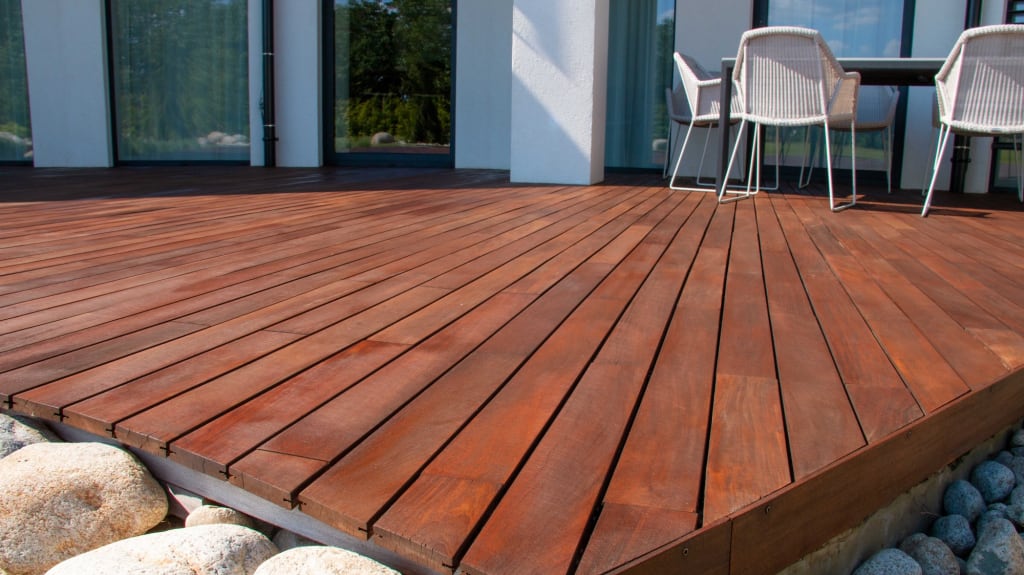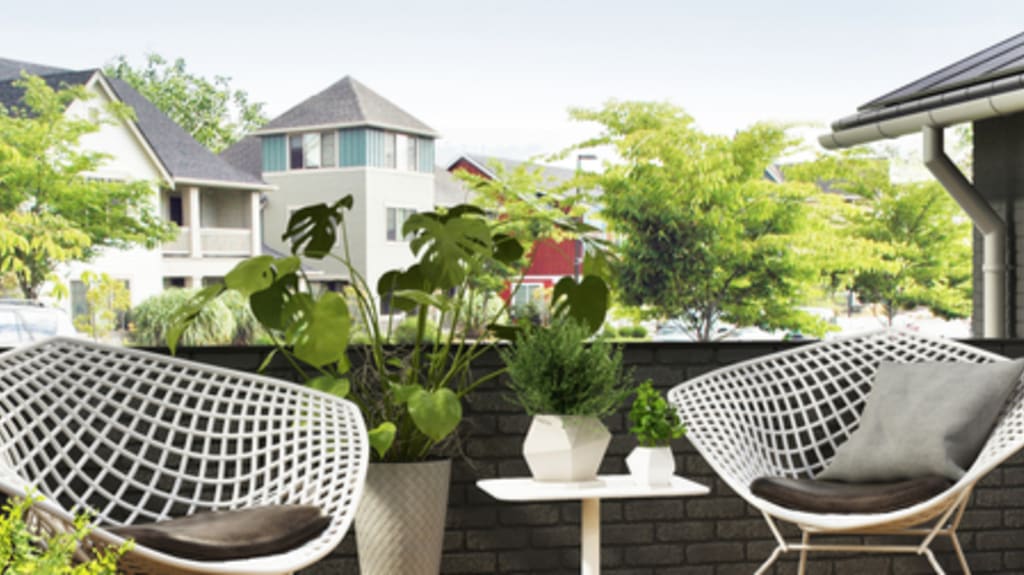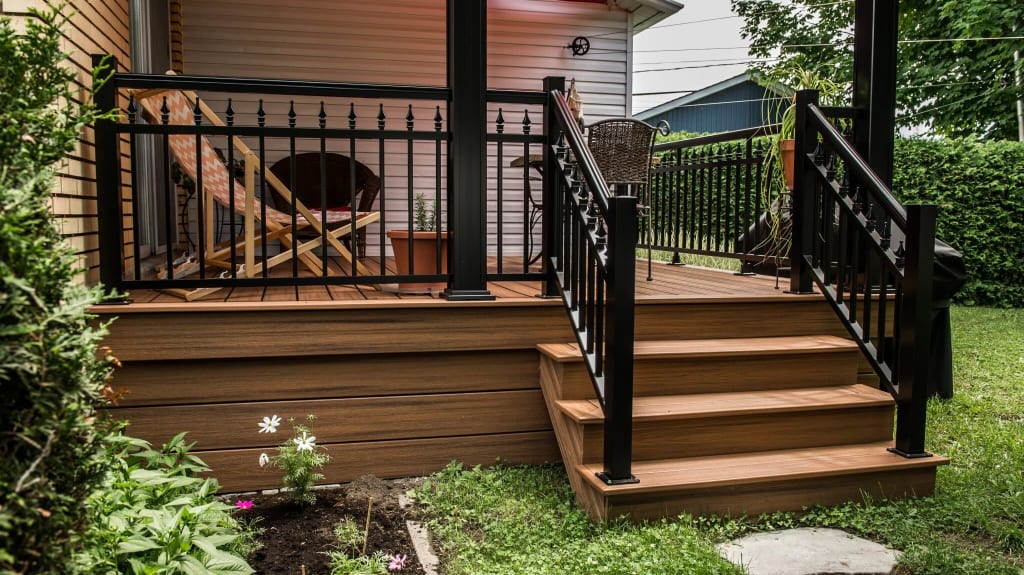Dreaming of a gorgeous terrace or brand-new balcony for summertime and wondering what decking material to choose? We’re here to tell you more about the seven main types of flooring. Browse through information on the most frequently used materials and their specific features before deciding on the ideal decking material for your outdoor living space

1. Fibreglass balcony and terrace
A fibreglass balcony is an excellent choice, according to Ingrid Jean-Brice, renovation advisor at RenoAssistance. Composed of wood plywood, this material is covered with an amalgam of fibreglass and polyester resin. It comes in various forms: with a drip edge, granite finish (more aesthetic) or plain (economical version). It can also be custom-made to your specifications. Affordable, offered in a range of colours, it’s quickly gaining in popularity. It’s also waterproof, requires little maintenance and has a lifespan of 20 to 25 years. A fibreglass balcony covering doesn’t tend to warp. Manufacturers offer a 10-year warranty. “This material’s only drawback: it can become slippery in rain or snow, and can crack when overheated,” says Mrs. Jean-Brice.
2. Wood balcony or terrace

Treated wood
This is considered to be the most popular material because it’s super easy to install and is a more than affordable option. Known for its warm appearance, treated wood nevertheless requires regular and rigorous maintenance. Indeed, it’s quite sensitive to weather changes and unfortunately is very prized by certain cellulose-loving insects (we’re talking here about carpenter ants, termites and house longhorn beetles). So it’s recommended to give a treated wood deck a good, gentle cleaning every couple of years, even annually, in addition to applying a coat of penetrating oil stain which should be done annually (excluding the first year). High-pressure washing should be avoided as it can erode the fragile surface. A treated wood deck or balcony can last between 10 and 15 years.
Torrefied wood
Torrefied wood has been treated in a high–temperature oven (between 160 °C and 245 °C). Its moisture content can be reduced to as little as 1%, compared with 12% for wood dried in a conventional kiln. This decking material is a natural product that includes no chemicals. Though water resistant, it’s important to ensure protection with a suitable oil or stain as it does has a tendency to fade when exposed to UV rays. The biggest selling point of torrefied wood is how long it lasts: between 50 and 60 years.
Cedar

Red or white cedar is the second most common type of balcony and terrace covering used in outdoor lounging areas. Unlike treated wood, cedar is the uncontested leader in terms of resistance to insects, fungi, splitting and moisture. This even-grained flooring offers great stain absorption. It’s still recommended to apply an oil-based product on cedar in order to maintain the protective barrier and shine. It boasts a 100% natural coating that can last up to 10 years. Interestingly, cedar is highly effective at cushioning acoustic transmission.
3. Composite balcony and terrace

Composite decking material is part of a very trendy club. Composed of wood fibres and thermoplastic polymers, it’s highly resistant to moisture, cracking and rotting. It has a wood-like finish. Slip-resistant and low-maintenance, composite flooring can remain in place for up to 25 years. This flooring is an eco-responsible choice that helps preserve forests ravaged by the exploitation of exotic species.
“Composite is in high demand,” says Ingrid Jean-Brice. “This floor covering has a significant lifespan and is easy to maintain compared to wood, which makes it popular with smaller budgets.”

Thinking of renovating?
4. Concrete balcony and terrace

Recognized for its durability and strength (up to 50 years when properly looked after), concrete is very popular and goes well with many design types. Consider concrete if you’re looking for an understated and classic style or even a more modern or industrial vibe.
“We’re seeing a growing interest in concrete balconies and terraces,” says Ingrid Jean-Brice. “A lot of people mistakenly think this is a costly material. However, it’s cheaper than composite and some manufacturers offer up to a five-year warranty for a concrete balcony.”
Waxed concrete

Waxed concrete is really in and is a product that gives floor coverings a glazed, chic and impeccable appearance. This mix of sand, cement and water is perfect for keeping cracks from forming on your balcony. It’s weather-resistant and shock-resistant. Keep in mind, however, that this product is not suitable for spaces with no roof or high-traffic areas (driveways, garages, around the pool, etc.), and its cost can be prohibitive.
5. PVC balcony and terrace
PVC is an excellent option that hides defects well on an uneven surface. This covering is made of a waterproof membrane that acts as a protective barrier on concrete or wood. So all you need is a simple soaping to clean it. PVC covering is quite heat resistant and this helps to maintain its original colour. It has a lifespan from 15 to 20 years and is guaranteed for five years. PVC is 100% waterproof and reacts well to de-icing salt.
6. Aluminum balcony and terrace
This flexible material doesn’t rust, is heat-resistant and easy to clean. It withstands insects and rodents. Its lifespan is around 40 years. This floor covering is about 20% more expensive than other products. Note it may have a slight risk of water infiltration after several years if the installation was not properly done. Lastly, when it comes time to replace part of your existing balcony or terrace that’s been around for several years, it will be challenging to find the same initial colour or a matching one. In fact, you may be out of luck as, due to the evolution of this market and colour choices, there is a scarcity of this material in certain shades.
7. Epoxy balcony and terrace

Epoxy is a resin based on a non-slip composite mixed with sand particles. During installation, a substrate (quartz sand) is sprinkled following the application of a thin layer of epoxy. The material is very popular for covering high–traffic areas (changing rooms, sports complexes, boutiques, businesses, garages, etc.) and also the floors of balconies and terraces. It’s not porous, unlike concrete. It’s also solid, durable, resistant to scratches, stains, flaking and acidic products. On top of that, it’s easy to clean. This product doesn’t yellow even with exposure to sunlight and provides an excellent bang for your buck. There are many texture and colour choices on the market. Odourless when applied, epoxy is waterproof and seamless. An epoxy floor can last between 15 and 30 years.
3 factors to consider when choosing your balcony or terrace decking material

Durability
This factor tops the list when searching for a balcony or terrace covering. “We see a marked increase in demand for balcony and terrace projects during peak season, both spring and summer. People are mostly looking for sustainable materials,” says Ingrid Jean-Brice, renovation advisor for RenoAssistance.
Weather conditions
The Canadian climate is known for its temperature fluctuations. Getting the right materials depending on where you live is key. Indeed, variable weather can negatively impact a balcony or terrace covering. Some floor coverings are more sensitive to light or heat while others crack after exposure to cold.
Colour
Natural tones provide a classic finish. Some types of covering are available in various colours and shades. There are also varnishes on the market in a variety of shades, which can glam up the surrounding décor.
“In addition to considering these factors,” adds the Renovation Advisor for RenoAssistance, “it’s recommended to have the dimensions of your draft project on hand and know your preferred styles and budget from the outset. That way, you can avoid unpleasant surprises and we will be able to better guide you through your project.”
Selecting the ideal balcony and terrace covering: a good investment?
Picking the right material to cover a balcony or terrace can make all the difference,” notes Ingrid Jean-Brice. “Whether you’re looking to do a simple renovation or a massive expansion, it’s better to be informed and get help from the right resources. Feel free to contact us. We can help you from project start to finish.”






